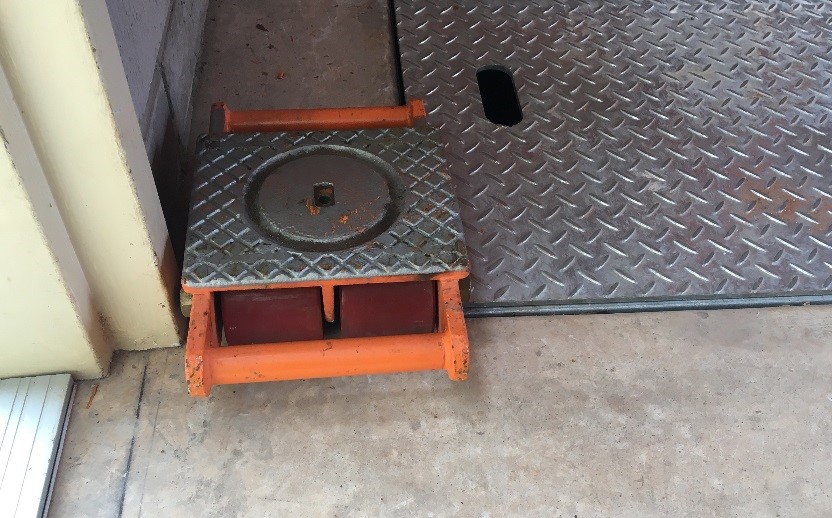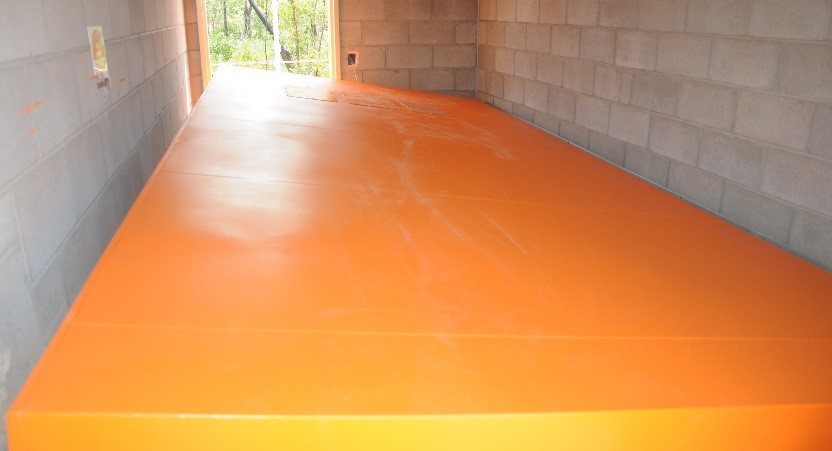Hazards of using load skates
This safety alert has been issued to highlight the risk of serious injury or death when using load skates to move top-heavy loads. Load skates are also referred to as machine or machinery skates, load trollies, heavy load dollies and load rollers.
Background
A worker received serious head injuries after being pinned between a wall and an electrical switchboard at the Palmerston Police Station construction site.
The switchboard weighed approximately 1.8 tonnes and was 4500mm long, 600mm wide and 2100mm high. A 75mm steel frame was also fitted to the base of the switchboard. The majority of the electrical components were installed towards the top of the switchboard, making it top heavy.
The switchboard was being manually manoeuvred on four load skates into a purpose-built switch room that was only 5010mm long and 2395mm wide. Three workers were pushing the switchboard over a cable pit covered by checker plates when the switchboard toppled backwards pinning the worker.
Preliminary findings indicate a skate came into contact with the edge of a checker plate (or the door frame), which dislodged a skate from under the switchboard causing it to topple.


Contributing factors included:
- The building design, planning and construction did not seem to take into consideration the dimensions and weight of the switchboard, meaning it had to be manually manoeuvred into position using load skates.
- The cable pit was almost the same length of the switchboard with only 100mm clearance either end, meaning the switchboard was not resting completely on the load skates, and the load skates had to travel along the edge of the checker plates.
- The load skates were originally part of and attached to a frame used to import sheet metal and may have not been designed for use in this manner.
- One corner of a checker plate did not sit flush with the floor and was raised.
- There was a high possibility of a skate dislodging if it hit an obstacle as there was no non-slip surface between the metal skates and the steel frame attached the switchboard.
- The switchboard had a high centre of gravity and was prone to toppling.
- There was no safe work procedure in place for using the skates.
- A site-specific risk assessment was not done and the workers did not have a clear understanding of all the hazards associated with using the load skates.
- The seriously injured worker was standing between the switchboard and a wall when it fell.
Action required
- Building designers and construction managers should take into consideration the dimensions of any large equipment that need to be housed in the building during the design and build phase.
- Ensure there are documented safe work procedures for the use of load skates in your business and all workers are aware of the potential hazards associated with using load skates.
- A site-specific risk assessment should be carried out before using load skates.
- Load skates should only be used on solid flat smooth surfaces, free from any obstructions.
- Match the correct skate design to the task being undertaken, always opt for skates with at least 25% more capacity than your load.
- The load should rest completely on the skate, and the skate plate should be fitted with a non-slip surface to prevent load shift or the skates dislodging.
- Use a temporary method of attaching the skate to the load to reduce to risk of load shift or skates dislodging.
- Particular care should be taken when moving top heavy loads or loads with a high centre of gravity, which should be considered a high risk activity.
- NEVER stand in a position between the load and a wall or other fixed structures to avoid the risk of becoming pinned and seriously injured.
- If two of more workers are manually moving a load, follow the team handling information on page 33 of the Code of Practice for Hazardous Manual Tasks.
- Inspect the skates regularly and follow manufacturer’s instructions for maintenance to ensure they remain in good working order.
Further information
For further information please refer to the following
Legislation
- Work Health and Safety (National Uniform Legislation) Act 2011 (Section 19)
- Work Health and Safety (National Uniform Legislation) Regulations 2011 (Regulations 34-38, 60 and 61)
Codes of practice
Guidance publications
Safety alert
Disclaimer
This Safety Alert contains safety information following inquires made by NT WorkSafe about an incident or unsafe practice. The information contained in this Alert does not necessarily include the outcome of NT WorkSafe’s action with respect to an incident. NT WorkSafe does not warrant the information in this Alert is complete or up-to-date and does not accept any liability for the information in this report or as to its use.